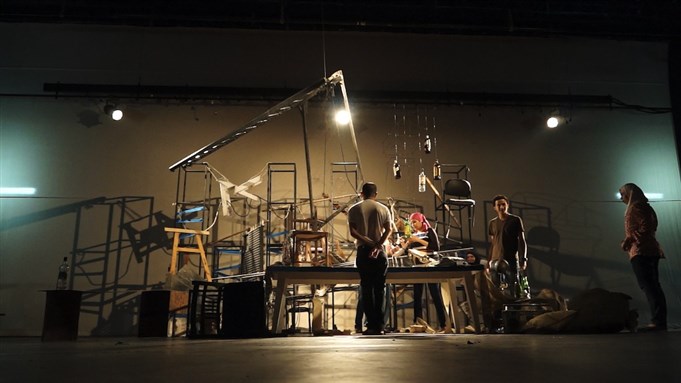Mahmoud Khaled:
Painter on a Study Trip
Gypsum Gallery, Cairo, Egypt
1 April - 6 May, 2014
Gypsum Gallery in Cairo opened only about a year ago in a leafy corner of the city’s Belle Époque neighborhood Zamalek. The Gallery has become a real presence in the local art scene rather quickly. With an active program of solo exhibitions, the Gallery’s director Aleya Hamza offers a unique space in Egypt that blends contemporary art’s critical frameworks with the commercial imperatives of a gallery. Showcasing midcareer artists mostly from Egypt, the Gallery provides a much-needed space and resources for new productions otherwise difficult to fund through regular channels (either public, commercial or NGO). Alexandria-based artist Mahmoud Khaled’s recent exhibition Painter on A Study Trip opened at Gypsum on 1 April and was almost entirely comprised of new work specifically developed for this occasion.
Khaled’s exhibition is one that begins with a quest for ideal form and instruction in arts, and ends with a philosophical justification for failure. This narrative is woven through a series of exercises that aim at attaining form in a specific historical moment when this quest itself is ideologically loaded. It is tainted with connotations of colonialism, nationalism, art bureaucracy, and hierarchical structural relationship inevitable in any instructional context, including art education. The form in question is that which encapsulates and crystalizes the age-old fine arts ideals of beauty and aesthetic standards, ideals promoted by the Enlightenment striving for cultivation and edification; ideals that were to elevate the modern human from the banality of everyday instrumental reason and to set him on the path of exploration of beauty. These ideals were considered as gateways to salvage the subject reduced to partiality through the domination of calculative rationality at the advent of developed capitalism. The encounter of man with the terrifying forces of nature as constitutive of the sublime and captured in painting was to offer a bridge between the subject and the object as ultimately separate and incommensurable while gratifying the increasingly cultivated aesthetic sensibilities of the bourgeoisie. What is at stake in Khaled’s project is the possibility of the sublime in an age when the sublime is produced technologically, as a spectacle.
The aesthetic ideals of beauty as explored through the classical heritage of the fine arts tradition have been harshly critiqued for their various universalist connotations. If modernism proposed new aesthetic ideals of pure form and medium specificity, as opposed to the academic standards of beauty found in referentiality and artisanal skill, the post WWII Euro-American art with its profound skepticism towards visuality and materiality announced the end of universal ideals found in particular forms for the sake of social and art-institutional critique.
Then, what does it mean today to evoke the memory of artisanal skill, fine arts instruction, and aesthetic beauty when the very concept of skill has shifted with the transformations in productive labor? Is Khaled’s project a conservative recapitulation and rehabilitation akin to the anti-conceptualist Stuckists’ movement return to classical aesthetic standards in the wake of contemporary art’s technical and discursive domination?Or is it a critical engagement through a variety of intertwined and complex questions that tap into historical consciousness, memory, institutional art education and artistic skill in the conditions of deskilling and reskilling of artistic labor?
Khaled’s exhibition Painter On a Study Trip is unequivocally the latter. Through a dialectical treatment of the past forms, the exhibition diligently and skillfully works through the above-noted complex traces of the past while subtly situating these in the historical specificity of the art institutional context in Egypt in the present. Rather than dichotomizing fine and contemporary art (out of which many other dichotomies emerge, such as ideological vs. critical, skillful vs. deskilled, conservative vs. progressive, state vs. the public sphere) the exhibition searches for ways to bring back historical consciousness and situate the present through form, medium, and material.
Painter on A Study Trip takes up an artwork housed at the recently re-opened Alexandria Museum of Fine Arts as its point of departure. Scognamiglio’s undated early twentieth century painting is photographed and framed by the artist. The work entitled Process (2014) confronts the viewer with the conditions of the contemporary techniques and technologies of observation as always already mediated by a multiplicity of historical and present-day frames: Scognamiglio framing two figures in a landscape, Khaled framing Scognamiglio’s painting with a hand-held mobile camera, and the viewer framing the artist’s framing of Scognamiglio with her look and most probably another technological imaging devise. Whereas in the original artwork the condition of framing the world as a picture is neutralized, in Khaled’s conceptual rendering the frame is the explicit device that constitutes the artwork in our contemporary age.
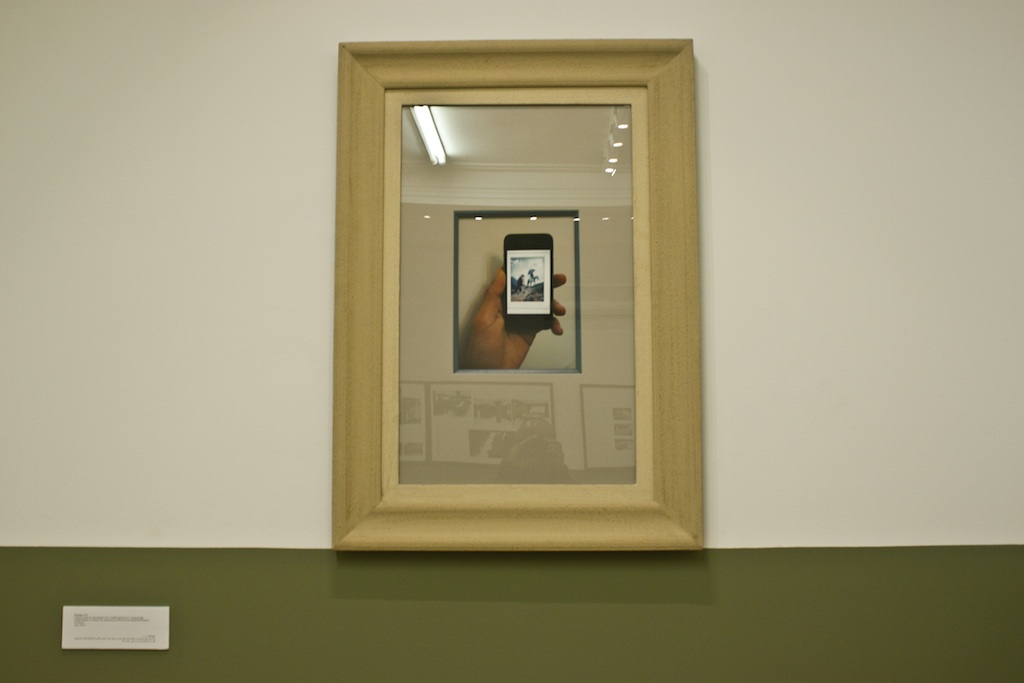 [Installation view of Process (2014). Image courtesy of the author.]
[Installation view of Process (2014). Image courtesy of the author.]
As someone who went through academic fine arts education, Khaled has probably undergone rigorous artisanal training with which he now grapples as an artist who operates in the globalized art world. In the landscape of contemporary artistic production the very notion of skill has been repositioned from hand-eye coordination to a variety of other conceptual, historical, and formal devices that constitute artistic labor. The tension between fine and contemporary art, artisanal skill and its de-skilling as well as the desire to recapture history through form and its failure underlie the space and structure of the exhibition.
In Exercise (2014) Khaled renders a trompe-l`œil mural painting of a classical Greco-Roman marble statue canonically leaning on a tree trunk with a plaque attached underneath. The plaque monumentalizes the trouble to draw a classical figure by an Alexandrian art student as a reminder of the difficulty to efface the traces of artistic labor. Positioned side-by-side to a C-print of a blank canvas (Material, 2014) the work reflects upon the formal, material, and labor conditions upon which fine arts is made possible. Yet, it is these conditions that have to be surpassed and sublated for an artwork to appear as “fine,” without any traces of its own materiality and the conditions of its production.
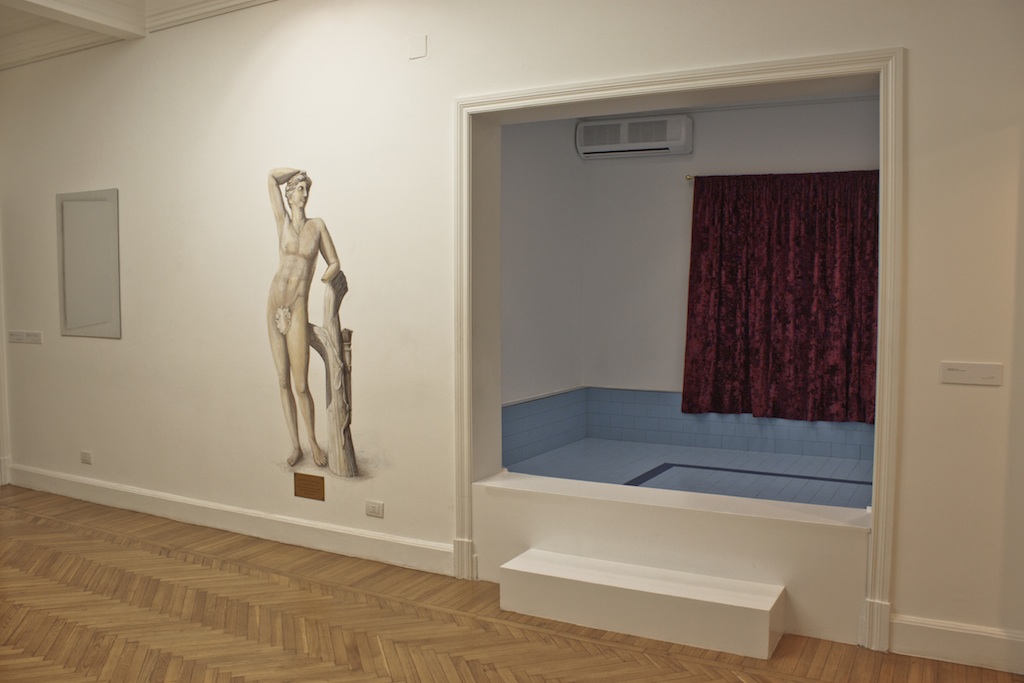 [Installation view of Exercise (2014) and the adjacent blue-tiled fountain of The Source (2014). Image courtesy of the author.]
[Installation view of Exercise (2014) and the adjacent blue-tiled fountain of The Source (2014). Image courtesy of the author.]
A series of photographic conceptual exercises follow in Detail (2014) wherein the memory of artisanal skill evoked in the two previous works are historicized as fragments of an age that failed to keep up with its own ideals. Khaled’s photographs of defunct fountains, glass-houses, concrete abandoned constructions, shapes no longer carrying the memory of their one-time utility and stairways without human traces in the Alexandrian garden of Antoniades refuse to recall the past nostalgically. Rather, deprived of their lived context and stripped of the utility they once possessed, these fragments carry the historical memory of their past through form. These are ghostly structures that appear as out-of-joint with the present, a present with drastically transformed aesthetic sensibilities and sites of leisure.
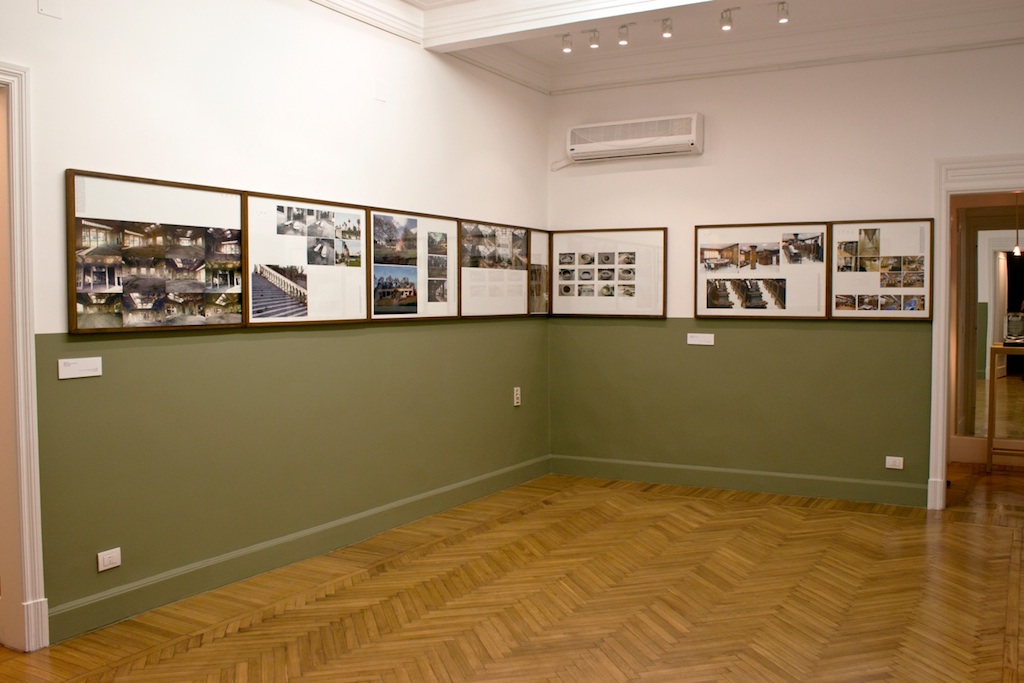 [Installation view of Detail (2013). Image courtesy of the author.]
[Installation view of Detail (2013). Image courtesy of the author.]
The Source (2014)—another juxtaposition of photographed and taxonomized sites with self-made instructions (“Sources for a study of a subject to be articulated at a later stage” reads the text followed with a description of the photographed objects) presents other kinds of forms, this time those of institutions and of bureaucracy. Panel-walled interiors with plastic and wooden chairs organized variously are combined with descriptive narratives written by the artist. One of the narratives refers to a student defending a thesis on revitalizing a public garden, and the other describes premises of an institution that “documents and researches the tangible and intangible heritage of an old coastal city and its sea, housed in a big public library.” In these photographic panels hope and despair appear side by side as the work both critically engages with institutional forms and locates the possibility of redemption within the institutional operations of education, research, and preservation. The institution here (whether of aesthetic instruction or heritage preservation) appears as an ornament through its various attributes, a form that refuses to speak back to the power that constitutes the institution. Instead, form comes into being as a sedimented archive that is no longer a repository of knowledge but a crystal of uncodifiable memory captured in specific structures and objects. The epitome of this sedimentation that associatively refers to the structures encountered in the Antoniades garden is the blue-tiled fountain to which a separate room in the gallery is dedicated. A red velvet curtain hangs on the side of this construction into which the viewer is called forth to step. As an installation with its strong material presence in the gallery space, this object endows the other works with a sculptural quality. Its reference is to form rather than function, and in and of itself the fountain is empty of signification; its sole operation (even if read as a minimalist sculpture or geometrical abstraction) is to act upon the works that it is enveloped by and that it envelops.
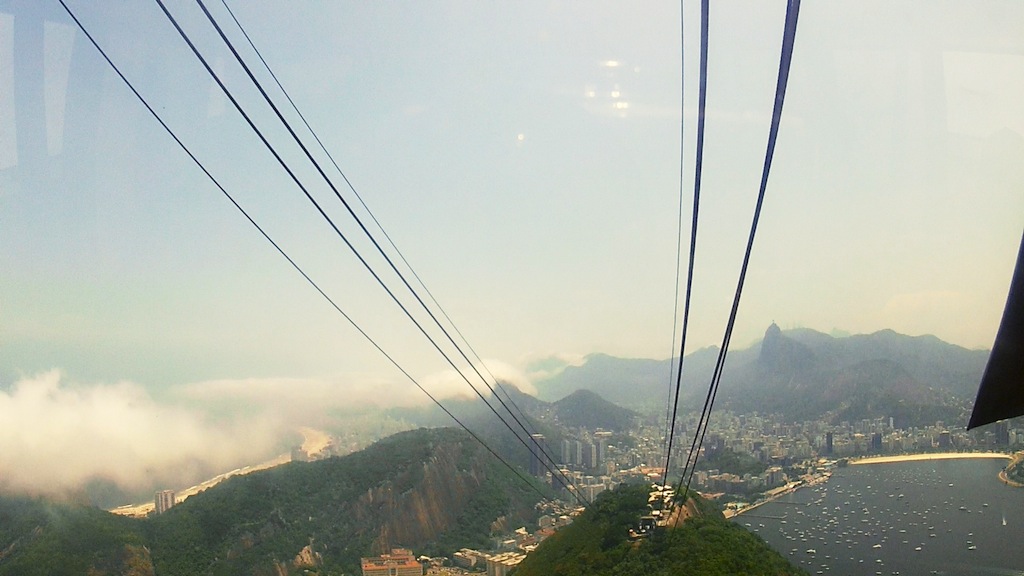 [Still from video portion of A Memorial to Failure (2013). Image courtesy of the author.]
[Still from video portion of A Memorial to Failure (2013). Image courtesy of the author.]
Painter On A Study Trip ends with A Memorial to Failure (2013). An ostentatious memorial plaque made of glass and put on a wooden pedestal inaugurates the artist’s encounter with the acclaimed radical philosopher from the Italian Autonomia movement Franco Berardi (knows as “Bifo”) in Khaled’s studio. The memorial leads to a room where the philosopher himself makes an appearance in video. Bifo’s monologue on life, death, fear, pleasure, and our share in changing the world evolves in the background of an aerial tramway ride from the hills above Jounieh, Lebanon to the coast and in Rio de Janeiro, Brazil. As the philosopher defends failure (in a somewhat aestheticized manner) against the twentieth-century ideologies of perfectionism, the camera follows the motion of the tramway enveloping the landscape of hills, forests, old houses, and the coast. The constant movement of the camera and the flow of Bifo’s words are only occasionally interrupted with still frames and verbal pauses. This flow of words and the steady camera motion combined with the vertiginous heights of the teleferik’s journey bring together the technological possibility to see the world from a bird’s-eye view with the philosophy’s age-old predilection of thinking the world from above. It is in the video that the loose threads of the exhibition come together as the aesthetic promise of the sublime is delivered through highly mediated technological means. The video takes the viewer back to the work based on Scognamiglio’s painting that makes the technological conditions of art production and reception explicit.
The show is ultimately about memory: memory of form, technique, and material that crystalize the dormant potential of failed past projects today.
![[Installation view of Mahmoud Khaled`s exhibition \"Painter on a Study Trip,\" which was recently held at Gypsum Gallery, Cairo. Image courtesy of the author.]](https://kms.jadaliyya.com/Images/357x383xo/CoverImage.jpg)









